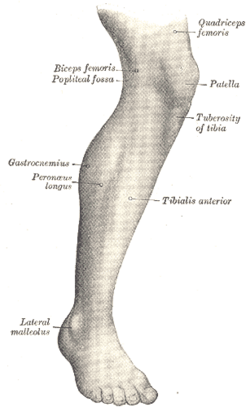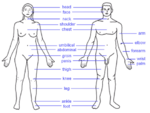Human leg
In common usage, the human leg is the lower limb of the body, extending from the hip to the ankle, and including the thigh, the knee, and the cnemis.[1] The largest bone in the human body, the femur, is in the leg.
In human anatomical terms, the leg is the part of the lower limb that lies between the knee and the ankle,[2] the thigh is between the hip and knee and the term "lower limb" is used to describe the colloquial leg. This article generally follows the common usage.
The leg from the knee to the ankle is called the cnemis (nee'mis) or crus. The calf is the back portion and the shin is the front.
Legs are often used metaphorically in many cultures to indicate either strength or mobility. The supporting columns of an object may be referred to as legs as well, as in chair legs.
Function and cultural aspects
Legs are often used for standing, walking, jumping, running, kicking, and similar activities, and are a significant portion of a person's mass.
Adolescent and adult females in many Western cultures often remove the hair from their legs. Toned, tanned, shaved legs are sometimes perceived as a sign of youthfulness and are often considered attractive in these cultures.
Rarely males also shave their legs, though this is not common practice in any part of the world (most often it is done for modelling or certain sports where speed is a requirement).
See also: Leg shaving & Leg shaving amongst men.
Anatomy

The muscles of the human lower leg
Muscles of the human lower limb
see Table of muscles
- Tibialis anterior
- Extensor hallucis longus
- Extensor digitorum longus
- Fibularis tertius
- Triceps surae (calf muscle)
- Gastrocnemius
- Soleus
- Plantaris
- Popliteus
- Flexor hallucis longus
- Flexor digitorum longus
- Tibialis posterior
- Peroneus longus
- Peroneus brevis
Vasculature of the leg
The arteries
- Femoral artery
- Profunda femoris
- Superficial femoral artery
- Popliteal artery
- Tibial artery
- Anterior tibial artery
- Posterior tibial artery
- Fibular artery
- Arcuate artery
The veins
- Greater saphenous vein
- Small saphenous
- Femoral vein
- Popliteal vein
- Anterior tibial vein
- Posterior tibial vein
- Fibular vein
See also
- Distraction osteogenesis (leg lengthening)
References
External links
|
General anatomy of lower limbs |
|
| Buttocks |
Gluteal sulcus - Gluteal cleft
|
|
| Thigh |
Fascial compartments of thigh (Anterior, Medial, Posterior)
Inguinal ligament • Pectineal ligament • Lacunar ligament • Reflected inguinal ligament • Conjoint tendon • Interfoveolar ligament
Obturator membrane/Obturator canal
Femoral triangle • Femoral sheath (Femoral canal) • Femoral ring
Adductor canal • Adductor hiatus
fascia/fascia lata (Iliotibial tract, Lateral intermuscular septum of thigh, Medial intermuscular septum of thigh, Fascia cribrosa/Saphenous opening) |
|
| Crus (anatomic leg) |
Popliteal fossa • Calf • Shin • Pes anserinus • Interosseous membrane of the leg
Fascial compartments of leg (Anterior, Lateral, Posterior)
fascia/crural fascia (Anterior crural intermuscular septum, Posterior crural intermuscular septum, Transverse intermuscular septum) |
|
| Foot |
Heel • Toe (Hallux, Fifth toe) • Sole • Achilles tendon • Tarsal tunnel
fascia (Plantar fascia)
retinacula (Peroneal, Inferior extensor, Superior extensor, Flexor) |
|
|
Bones of lower limbs |
|
| Femur |
|
upper extremity
|
head (fovea) · neck · greater trochanter (trochanteric fossa) · lesser trochanter · intertrochanteric line · intertrochanteric crest
|
|
|
body
|
linea aspera · gluteal tuberosity / third trochanter · pectineal line
|
|
|
lower extremity
|
adductor tubercle · patellar surface · epicondyles (lateral, medial) · condyles (lateral, medial) · intercondylar fossa
|
|
|
| Crus |
|
Tibia
|
|
upper extremity
|
condyles (lateral, medial) · intercondylar eminence (lateral/medial intercondylar tubercle) · posterior/anterior intercondylar area
|
|
|
body
|
tuberosity · soleal line
|
|
|
lower extremity
|
medial malleolus · fibular notch
|
|
|
|
|
head · body · lateral malleolus
|
|
|
Other
|
patella
|
|
|
| Foot |
|
Tarsus
|
calcaneus (sustentaculum tali, trochlear process) · talus (body, neck, head) · navicular · cuboid · cuneiform (medial, intermediate, lateral)
|
|
|
|
1st metatarsal · 2nd · 3rd · 4th · 5th
|
|
|
Other
|
phalanges of the foot
|
|
|
|
Joints and ligaments of lower limbs |
|
| Coxal/hip |
femoral (iliofemoral, pubofemoral, ischiofemoral) - head of femur - transverse acetabular
|
|
| Knee-joint |
extracapsular: patellar - popliteal (oblique, arcuate) - collateral (medial/tibial, fibular/lateral)
intracapsular: cruciate (anterior, posterior) - menisci (medial, lateral) - transverse
|
|
| Tibiofibular |
|
Superior tibiofibular
|
anterior of the head of the fibula - posterior of the head of the fibula
|
|
|
Inferior tibiofibular
|
anterior of the lateral malleolus - posterior of the lateral malleolus
|
|
|
| Talocrural/ankle |
medial: medial of talocrural joint/deltoid (anterior tibiotalar, posterior tibiotalar, tibiocalcaneal, tibionavicular)
lateral: lateral collateral of ankle joint (anterior talofibular, posterior talofibular, calcaneofibular)
|
|
| Foot |
|
Subtalar/talocalcaneal
|
anterior/posterior - lateral/medial - interosseous
|
|
|
Transverse tarsal
|
|
Talocalcaneonavicular
|
dorsal talonavicular - plantar calcaneonavicular/spring - bifurcated (calcaneonavicular)
|
|
|
Calcaneocuboid
|
dorsal calcaneocuboid - long plantar - plantar calcaneocuboid - bifurcated (calcaneocuboid)
|
|
|
|
Distal intertarsal
|
|
Cuneonavicular
|
plantar - dorsal
|
|
|
Cuboideonavicular
|
plantar - dorsal
|
|
|
Intercuneiform
|
plantar - dorsal - interosseous
|
|
|
|
Other
|
|
Tarsometatarsal/Lisfranc
|
plantar - dorsal
|
|
|
Intermetatarsal/metatarsal
|
plantar - dorsal - interosseous - superficial transverse - deep transverse
|
|
|
Metatarsophalangeal
|
plantar - collateral
|
|
|
Interphalangeal
|
plantar - collateral
|
|
|
|
Arches
|
Longitudinal - Transverse
|
|
|
|
List of muscles of lower limbs |
|
ILIAC Region
/ ILIOPSOAS |
psoas major/psoas minor - iliacus
|
|
| BUTTOCKS |
gluteals: (maximus, medius, minimus) - tensor fasciae latae
lateral rotator group: piriformis - inferior gemellus - obturator internus - superior gemellus - quadratus femoris
|
|
| THIGH |
|
Anterior
|
sartorius - quadriceps (rectus femoris, vastus lateralis, vastus intermedius, vastus medialis) - articularis genu
|
|
|
Posterior/hamstring
|
biceps femoris - semitendinosus - semimembranosus
|
|
|
Medial
|
pectineus - obturator externus - gracilis - adductor (longus, brevis, magnus)
|
|
|
| LEG |
|
Anterior
|
tibialis anterior - extensor hallucis longus - extensor digitorum longus - peroneus tertius
|
|
|
Posterior
|
superficial - calf/triceps surae (gastrocnemius, soleus) - plantaris
deep - tarsal tunnel (flexor hallucis longus, flexor digitorum longus, tibialis posterior) - popliteus
|
|
|
Lateral
|
peroneus muscles (longus, brevis)
|
|
|
| FOOT |
|
Dorsal
|
extensor hallucis brevis - extensor digitorum brevis
|
|
|
Plantar
|
1st layer (abductor hallucis, flexor digitorum brevis, abductor digiti minimi)
2nd layer (quadratus plantae, lumbrical muscle)
3rd layer (flexor hallucis brevis, adductor hallucis, flexor digiti minimi brevis)
4th layer (dorsal interossei, plantar interossei)
|
|
|
|
List of arteries of lower limbs |
|
| EI: Femoral |
|
Superficial
|
superficial epigastric – superficial iliac circumflex
|
|
|
External pudendal
|
superficial – deep (anterior scrotal)
|
|
|
Profunda femoris
|
lateral circumflex femoral (descending, transverse, ascending) – medial circumflex femoral (ascending, superficial, deep, acetabular) – perforating
|
|
|
Descending genicular
|
saphenous branch – articular branches
|
|
|
Popliteal
|
|
Sural
|
no major branches
|
|
|
Genicular
|
superior genicular (medial, lateral) – middle genicular – inferior genicular (medial, lateral)
|
|
|
Anterior tibial
|
tibial recurrent (posterior, anterior)
anterior malleolar (medial, lateral)
dorsalis pedis: tarsal (medial, lateral)
|
|
|
Posterior tibial
|
circumflex fibular – fibular
medial plantar – lateral plantar
|
|
|
Arches
|
arcuate: dorsal metatarsal / first dorsal metatarsal – deep plantar – dorsal digital arteries
plantar arch: plantar metatarsal – common plantar digital – proper plantar digital
|
|
|
|
|
Veins of lower limbs |
|
| thigh |
femoral • profunda femoris • popliteal
|
|
| deep leg |
fibular • anterior tibial • posterior tibial
|
|
| superficial leg |
small saphenous • great saphenous (external pudendal, superficial of penis ♂/clitoris ♀)
|
|
| foot |
dorsal arch • dorsal metatarsal • dorsal digital • plantar arch • plantar metatarsal • common digital • plantar digital
|
|
|
Nerves of lower limbs and lower torso: the lumbosacral plexus (L1-Co) |
|
| lumbar plexus (L1-L4) |
|
iliohypogastric
|
lateral cutaneous branch - anterior cutaneous branch
|
|
|
ilioinguinal
|
anterior scrotal ♂/labial ♀
|
|
|
genitofemoral
|
femoral branch/lumboinguinal - genital branch
|
|
|
lateral cutaneous of thigh
|
patellar
|
|
|
obturator
|
anterior (cutaneous) - posterior - accessory
|
|
|
femoral
|
anterior cutaneous branches - saphenous (infrapatellar, medial crural cutaneous)
|
|
|
| sacral plexus (L4-S4) |
|
sciatic
|
|
common fibular
|
lateral sural cutaneous (sural communicating branch) - deep fibular (lateral terminal branch, medial terminal branch, dorsal digital) - superficial fibular (medial dorsal cutaneous, intermediate dorsal cutaneous, dorsal digital)
|
|
|
tibial
|
medial sural cutaneous - medial calcaneal - medial plantar (common plantar digital nerves, proper plantar digital) - lateral plantar (deep branch, superficial branch, common plantar digital, proper plantar digital)
|
|
|
sural
|
lateral dorsal cutaneous - lateral calcaneal
|
|
|
|
other
|
muscular: superior gluteal/inferior gluteal - lateral rotator group (to quadratus femoris, to obturator internus, to the piriformis)
cutaneous: posterior cutaneous of thigh (inferior cluneal, perineal branches) - perforating cutaneous
|
|
|
| coccygeal plexus (S4-Co) |
pudendal: inferior anal - perineal (deep, posterior scrotal ♂/labial ♀) - dorsal of the penis ♂/clitoris ♀
anococcygeal
|
|
|
cutaneous innervation of the lower limbs
|
|
|
Lymphatics of lower limbs |
|
| Inguinal |
Deep inguinal - Superficial inguinal
|
|
| Other |
Popliteal
|
|


